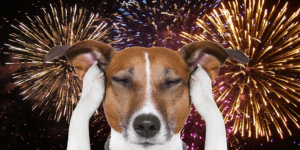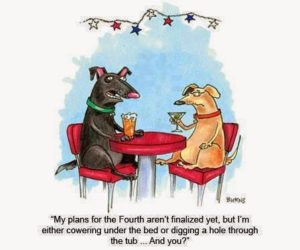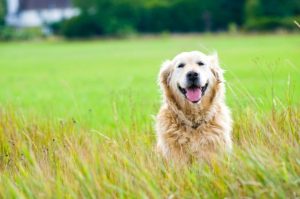 The month of July is chock-full of patriotic festivities that include outdoor celebrations, picnics, barbecues, and of course, fireworks. Before you pack up for the lake or outdoor arena, stadium or even your own front yard to enjoy the pyrotechnic delights of the holiday, be aware of your pets’ needs and fears.
The month of July is chock-full of patriotic festivities that include outdoor celebrations, picnics, barbecues, and of course, fireworks. Before you pack up for the lake or outdoor arena, stadium or even your own front yard to enjoy the pyrotechnic delights of the holiday, be aware of your pets’ needs and fears.
Animal shelters experience a significant increase in the number of lost (and injured) pets after every July Fourth holiday.
Even pets who are normally calm and obedient can show unpredictable behavior when frightened. Dogs and cats can become frightened or confused by the excitement and loud noises of the holiday. I have been involved with rescuing terrified pets who had chewed through their tethers, jumped through plate glass windows or over fences, and escaped “secure” enclosures.
Dogs attempting to flee the frightening, and even painful noises of the fireworks may lose their sense of direction and run long distances risking injury or death as they dart in and out of traffic. This is one of the most dangerous times of year for your pets.
Up close, fireworks can burn or injure your pets, but even if they are far away, they still pose a unique danger to your companion animals.
To minimize the danger to your pets take these few simple steps before you set out to celebrate this Fourth of July:
- Keep pets indoors in an enclosed area that they are familiar with to minimize fear. If possible, turn on a radio to mask the noise of the fireworks or other celebratory noises.
- If your pet is excitable, consult your veterinarian to arrange for the administration of a proper calming drug ahead of time.
- If you have to be away for an extended time, board your pets with family or friends you trust and who can assure you that your pet will be kept confined and cared for.
- Always be sure your pet has a current microchip. A microchip is the best identification for a pet because it is always with him. A microchip makes it easier for animal control to find you should the unthinkable happen and your pet manages to escape.
- Even if you think your pet is ok with fireworks and noise, do not let him out when fireworks are being lit and set off. The pet may run at them and sustain serious burns, or bolt and run away.
If your pet does escape this holiday, visit your local shelter every day and post “Lost Dog” or “Lost Cat” signs and canvass surrounding neighborhoods. Place a yard sign in front of your house with a picture of your pet and your phone number. People who find lost pets will often walk or drive around the area attempting to find the owner. This Fourth of July can be the best ever if you take these simple precautions to keep your pets safe and happy. Let’s enjoy the festivities without having to worry about the family pet.
Source: 4th of July Pet Tips

 Every year every community decides to wreak massive mayhem among our companion animals. If you’re a pet owner, you know I’m talking about the Fourth of July. Fireworks terrify pets.
Every year every community decides to wreak massive mayhem among our companion animals. If you’re a pet owner, you know I’m talking about the Fourth of July. Fireworks terrify pets. Your pet has a deadly enemy that comes in the form of several species of grassy weeds that grow rapidly during the winter/spring rains. When these grasses mature a seed forms at the top of the stalk resembling a fox tail.
Your pet has a deadly enemy that comes in the form of several species of grassy weeds that grow rapidly during the winter/spring rains. When these grasses mature a seed forms at the top of the stalk resembling a fox tail. Foxtail seeds are relatively small, so detecting them after they enter a dog’s body can be difficult. Veterinarians usually rely on telltale symptoms such as head-shaking, paw licking, swellings on the body, or sudden and continuous sneezing. Foxtails in the ears, nose and eyes are serious and can ultimately be life-threatening if not treated promptly.
Foxtail seeds are relatively small, so detecting them after they enter a dog’s body can be difficult. Veterinarians usually rely on telltale symptoms such as head-shaking, paw licking, swellings on the body, or sudden and continuous sneezing. Foxtails in the ears, nose and eyes are serious and can ultimately be life-threatening if not treated promptly. These are challenging times for government officials. In many communities the care of lost and homeless animals can be complicated by a host of competing priorities. When evaluating conflicting priorities it’s easy to look to the bottom line. When that happens, questions of compassion can be overlooked.
These are challenging times for government officials. In many communities the care of lost and homeless animals can be complicated by a host of competing priorities. When evaluating conflicting priorities it’s easy to look to the bottom line. When that happens, questions of compassion can be overlooked.